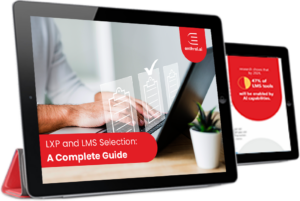The What, Why and How of a Skills Taxonomy for Learner Upskilling

Organizations globally are facing significant skills shortages, with the World Economic Forum’s Future of Jobs Report 2023 pointing out that 44% of workers’ skill sets are at risk of disruption over the next five years. Furthermore, despite growing job displacement due to AI proliferation, an estimated 97 million new roles are likely to emerge by 2025 to meet the needs of this AI-fueled economy.
Bottom-line: organizations will not only need more workers, but will also have to intensify their efforts to enhance their workforce’s skill sets to meet changing demand. Skills are the current currency of work, so a business’ most valuable assets are its people as well as their skills.
Given this context and the mandates from top management to find more effective methods to bridge skill gaps, a crucial starting point for most L&D teams is to inquire about the means to achieve this. However, a more basic query that we need to begin with is: what is your organization’s skills taxonomy?
Before moving on, let’s talk about what a skills taxonomy is.
What is a Skills Taxonomy?
A skills taxonomy is a structured framework that defines the various skills, knowledge and abilities required to perform specific tasks. It systematically organizes these skills and provides a basis for improvement when needed.
A skills taxonomy also provides the necessary structure for companies to evaluate, enhance, measure and nurture key skills that directly contribute to business success.
Developing a skills taxonomy starts with pinpointing the skills and competencies that are necessary for a specific position. This includes identifying the knowledge, hard and soft skills and abilities needed for success in that role.
You may further categorize skills by proficiency levels or their significance to the position. Subsequently, you can build skill clusters, which are collections of roles that demand a similar skill set. This step helps identify skill overlaps and shows how certain skills are relevant to multiple positions within your organization.
Role of a Skills Taxonomy
Skills taxonomies play a key role in the evolving strategies of companies in hiring and nurturing talent. Previously, more often than not, a role-centric strategy was preferred for hiring and development. This meant recruiting and training individuals based on the duties that were needed for a particular role. This conventional approach generally provided a holistic evaluation of the employee and aligned skills and experiences with a broadly defined title, like “Sales Manager” or “Customer Success Executive.”
Contrary to the role-based strategy, a skills-based approach separates positions into essential skill necessities and then evaluates an individual’s capabilities, aligning skills with an immediate or prospective requirement.
Although there is no definitive correct method, an increasing number of organizations are transitioning to a skills-based approach due to its emphasis on unique abilities, moving away from the limitations of job descriptions.
Paying too much attention to positions over skills could lead to overlooking the crucial nuances inherent in each role. Furthermore, with a role-centric system, you may have qualified individuals suitable for important roles without realizing it. By redirecting the focus onto the fundamental skills that drive your organization, you can more easily transition individuals into what may seem to be unrelated positions that demand similar skills, and then upskill/reskill them to address any gaps.
With a skills-focused approach, a taxonomy becomes a valuable tool since it gives your organization a common vocabulary for discussing and understanding skills.
Skill Taxonomies & Competency Models: Key Differences
While the terms “skills” and “competencies” are often used interchangeably, there are differences in their meanings within a workplace context. When developing a skills taxonomy, it is necessary to understand these differences.
Gartner defines skills as “the observable manual capabilities required in the execution of a job or task. They define “what” is performed within a job.” Competencies are defined as “the set of characteristics of an individual that are observable, measurable and predictive of superior performance within a given role or job.”
In other words, skills constitute the elements that contribute to the construction of a competency. For instance, the ability to communicate effectively is a competency. Skills that aid in effective communication include writing concisely, speaking confidently and drafting clear, easy-to-understand documents.
As skill gaps widen across various industries, traditional talent models, such as competency models, fall short in addressing these gaps.
Competency models are a bit complex and they are rarely utilized in the way L&D leaders want because of their tendency to quickly become obsolete. In contrast, skill taxonomies emphasize the practical capabilities individuals possess for specific roles, consistently adapting to incorporate emerging skills and phase out outdated ones.
Utilizing a skills taxonomy that resonates with the workforce’s strengths enables companies to upskill or reskill employees in critical areas requiring improvement. With a well-designed skills framework, companies can aim, execute, and achieve their objectives effectively.

LXP and LMS Selection: A Complete Guide
- Decoding & comparing LXP and LMS
- Practical applications for LXP and LMS
- Critical considerations in selecting the best system
Benefits of a Skills Taxonomy
Implementing a well-structured skills taxonomy can bring about several benefits:
- It can equip your organization with the ability to allocate the right learning resources to the right individuals. Understanding the most crucial skills your organization requires enables you to design learning initiatives that effectively prepare your workforce with the necessary training to tackle skills deficiencies.
- It can facilitate a fair evaluation of a job candidate by aligning the specific skills necessary for the job with the candidate’s specific skills. This reduces the ambiguity and inconsistency often found in traditional hiring methods.
- It provides guidance for conducting a skills gap analysis by establishing a shared vocabulary of skills and their definitions.
- It removes the confusion (if any) in identifying the critical skills required for role success. This, in turn, allows L&D to more effectively support individual employee development and goal-setting.
- It enhances transparency related to internal mobility strategies. This helps employees, managers and L&D teams to have a clear understanding of the skill sets required for employees to progress within the company or transition to a new role in another department.
- It keeps L&D teams better informed about emerging skills trends, providing the foresight needed to anticipate future skill requirements proactively.
- It helps L&D to better identify relevant learning opportunities that enable employees to enhance their skills and competencies.
Wrapping Up
Informed L&D decisions rely heavily on a comprehensive and regularly updated skills taxonomy, as it forms the basis for all skills assessments and subsequent decision-making. The quality and consistency of the data are paramount for producing meaningful results.
Maintaining a consistent skills vocabulary is the first step toward conducting a good skills gap analysis, improving hiring practices, and finally, creating relevant L&D initiatives that allow employees to enhance their skills both now and in the future.











